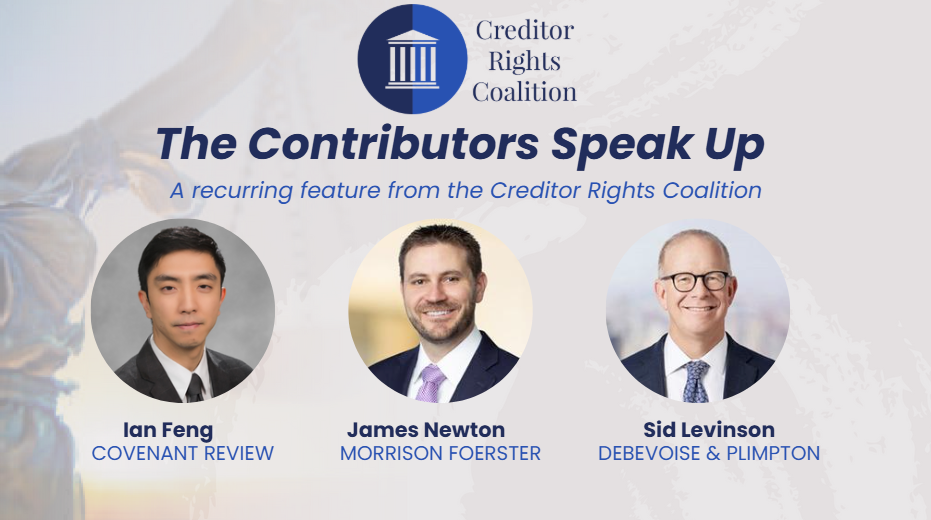The latest Game of Whack-a-Mole between Sponsors & Lenders

Between anti-coop provisions, expanding DQ lists, and now anti-counsel language, the game of whack-a-mole for negotiating leverage is changing faster than a Mason Miller fastball! We asked our expert contributors Ian Feng, Sid Levinson, and James Newton to break down what’s happening now and what’s coming next.
They cover the same terrain from different angles: Feng warns that borrower-engineered terms—anti-cooperation/counsel clauses, broad DQ lists, and voting/assignability constraints—pre-wire LMTs by controlling both process and who holds the pen, so lenders must push back at issuance. Levinson uses game theory to show how inclusive cooperation agreements (with early-joiner economics and tradable “coop debt”) can disrupt sponsor “pick-off” strategies and improve aggregate outcomes while limiting litigation risk. Newton is the realist: as long as CLO-driven demand persists sponsors will keep stretching terms; and documentation terms may just limit secondary liquidity and concentrate advantages with the largest players.
Ian Feng
Covenant Review
Liability management transactions (or LMTs) increasingly resemble an arms race where only borrowers are armed. Provisions that tilt the field toward borrowers are poised to determine how future LMTs unfold, particularly in the broadly syndicated loan (BSL) market. These provisions fall into two categories: (1) process control (e.g., anti-cooperation / anti-counsel) and (2) syndicate and/or voting control (e.g., expansive DQ lists, voting limitations, and assignability constraints).
Process control, because it implicates enforceability and questions the good faith of the principals, is the more controversial of the two. The implications of provisions that prevent lender cooperation or engagement of counsel is—beyond the obvious shot across the bow from borrowers—largely behavioral. These provisions chill lenders’ enthusiasm during LMT negotiations by injecting just enough legal uncertainty and friction to deter cooperation and engagement. Enforceability of such provisions (or indeed the practicality of monitoring compliance) is a valid question; but whether any lender will actually test it in court is another. Borrowers count on that hesitation. The symbolism of these provisions alone can reset expectations and reduce resistance in coercive scenarios.
Syndicate / voting control is more common than process control but potentially more insidious. These provisions have taken on a number of forms over the past few years, including, but not limited to: (1) absolute borrower consent rights over assignments to “distressed investors,” (2) absolute consent rights over assignments that would cause a single lender (including affiliates) to exceed a negotiated cap (e.g., 20% of outstanding term loans), (3) caps on lender voting in excess of a threshold amount, (4) net short disenfranchisement (excluding lenders who hold or who have affiliates that hold a “net short” position in the CDS market relative to the loan), and (5) in rare cases, retroactive disqualification of existing lenders—enabling a forced “yank” and reassignment to more cooperative holders. These provisions give the borrower decisive influence over who holds the pen in any LMT negotiation.
Because syndicate and voting constraints often fly under the radar during fast-paced marketing processes, they are proliferating with little pushback within the BSL space. This could cause unintended consequences for the market at large. If lenders fear that they may be forced to sell their loans at a discount or be boxed out ex post, they may hesitate or even abstain from investing, reducing syndicate depth. The trajectory of syndicate control could, if unchecked, also move toward European-style limited “whitelists” for assignability.
Bottom line? Borrowers are setting the rules for LMTs well in advance of any need for such rules, shaping both the process and the player bench to minimize opposition when LMTs arise. Lenders that fail to identify and negotiate these terms upfront will face constrained options later—precisely when flexibility matters most. Greater discipline at issuance and an educated lender pool are the only practical countermeasures. The unanimous rejection of anti-cooperation language in the BSL market thus far strongly indicates that creditors have at least begun to recognize the threat.
Sid Levinson
Debevoise & Plimpton
Are cooperation agreements among lenders here to stay? Game theory concepts offer some potential insight. Professor Samir Parikh, in his 2023 article “Creditors Strike Back: The Return of the Cooperation Agreement” (Duke Law Journal Online 73 (1):1-40), provides a primer on the Multiplayer Prisoner’s Dilemma and its application to liability management exercises, which succeed best when individual lenders are unable to cooperate and forced to choose between a bad outcome or a worse one. Absent such cooperation, the existence of “Nash equilibrium” – meaning no player can improve their outcome by changing their decision, assuming the other players’ choices remain unchanged – has left many lenders forced to accept suboptimal recoveries than could have been improved through cooperation. (J. Crew and Pet Smart).
On the other hand, Nash equilibrium (named after mathematician John Forbes Nash, Jr. and based on his 1951 article “Non-Cooperative Games”) destabilizes when players can make binding agreements. Cooperation agreements, which date back more than 20 years (shout out to Bruce Bennett), enable lenders to obtain greater aggregate benefit by limiting the ability of borrowers to pick off individual lenders at the expense of others. (Spectrasite, Caesars, iHeart). But for a time in the early 2020s, cooperation agreements were used offensively by a select group of lenders to effectuate rather than prevent LMEs. This splintering of lenders, ironically under the “cooperation” banner, enabled borrowers to capture value (i.e., more favorable interest rates and terms) that otherwise would have flowed to the minority lenders. (Serta). It also led to a cottage industry of litigation that negatively impacted all players and sometimes landed the borrowers in bankruptcy.
More recently, as described in Brett Seaton’s 2025 thesis, “The Value and Legality of Lender Cooperation Agreements” (Wharton School, University of Pennsylvania), cooperation agreements have evolved such that they are open to all lenders but provide “carve-outs” for initial or early participants, ostensibly to compensate them for their investment of time and expense and willingness to become restricted. Such agreements also have the virtue of enabling majority lenders to realize the value of any implicit “control premium” in their debt, while minimizing the risk of litigation with minority lenders that can otherwise eradicate any benefit obtained from their wholesale exclusion. As an added benefit, the liquidity of “coop debt” in the secondary market versus other debt discourages freeriding which otherwise impedes cooperation.
Faced with this refinement, borrowers have tried to find new ways to disrupt the ability of lenders to cooperate. The expansion of DQ lists to exclude activist debt investors is one tool, but as Scott Greenberg has taught us, even behemoth institutions who buy debt upon issuance can be corralled. Some of the more recently proposed new tools are less imaginative, such as prohibition of cooperation agreements or of the retention of law firms that regularly represent ad hoc groups. So far, those legal solutions have not gotten much traction. Borrowers may need to get more creative. Here, again, game theory concepts may offer a more fruitful path. As one example (admittedly impracticable), if no single lender could hold or acquire more than 1% of a loan, the challenge of organizing such a disparate and less invested group would be magnified. Of course, so would obtaining their consent when needed to amend the loan agreement. (Perhaps credit agreements could provide for lender consent on negative notice from the administrative agent, or a majority of those who respond, but that would be quite revolutionary). In any event, private equity firms and investment bankers seem better equipped than lawyers to design a landscape that allows Nash equilibrium to not only exist but flourish.
James Newton
Morrison & Foerster
I loathe sounding like an eternal pessimist, but I am a restructuring lawyer and so perhaps it is part of my DNA. For so long as there continues to be an insatiable appetite for new loan allocations and the typical allocation received by each lender is small relative to the size of the vehicle acquiring it (as in the case of virtually all CLOs), I expect sponsors to continue to push the envelope successfully. And if the market is willing to accept terms, saying that these efforts “go too far,” or that there is some arbitrary line in the sand that should not be crossed seems a bit disingenuous.
While we should expect that some sponsor efforts will have material impacts on workout and restructuring efforts, many likely will not. For example, I expect that the counsel DQ lists will not have a huge impact initially, since the veto right can be waived by the borrower as a condition to lenders engaging on solutions (just like entry into a fee letter with counsel of choice is often a prerequisite to engagement by bondholders).
Anti-coop provisions and ever-expanding lender DQ lists, on the other hand, may have more of an effect. They will have some effect on the leverage dynamics for workouts, of course, but may also have a real impact on liquidity. As more and more natural secondary buyers are DQ’ed or choose not to buy in until after the first LME shoe drops, par lenders may find it more and more difficult to find a buyer and exit their positions. To me, this is just another self-reinforcing dynamic that benefits the largest players and feeds further consolidation in the CLO market.
Copyright Creditor Rights Coalition 2025
